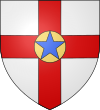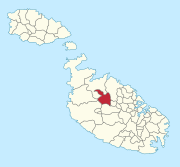Mosta
| coat of arms | map |
|---|---|

|
|
| Basic data | |
| State : | Malta |
| Gzejjer : | Malta Majjistral (Northwest Malta) |
| Distretti : | Northern |
| Area : | 6,778,015 km² |
| Residents : | 20,988 (December 31, 2018) |
| Population density : | 3096 inhabitants / km² |
| ISO 3166-2 : | MT-32 |
| Postal code : | MST |
| Website : | www.mostalocalcouncil.com |
| politics | |
| Mayor : | Paul Chetcuti Caruana ( MLP ) |
Coordinates: 35 ° 54 ' N , 14 ° 26' E
Mosta is a city in the north-western center of the Mediterranean island of Malta with 20,988 inhabitants (as of December 31, 2018), the area of which was already settled in the Copper Age (4100-2500 BC).
geography
Mosta is about nine kilometers from the capital Valletta and is on the road to Bugibba. The surrounding area lies in a fertile plain for Malta's standards, which is bordered to the northwest by the ridge of the Victoria Lines . The neighboring town of Naxxar is immediately northeast.
history
The place name Mosta is probably derived from the Arabic word musta , which means something like middle, and thus probably reflects the location of the place on the island. Mosta is one of the oldest settlements on Malta, as archaeological finds show that people lived here as early as prehistoric times. In the Middle Ages Mosta with its catacombs was a refuge for the population when pirates raided the island with their raids. However, the population grew only very slowly. Later, due to its favorable scenic location, the place developed into the center of Maltese agriculture, smaller places near the first settlement (e.g. Rahal Calleja, Rahal Sir, Rahal Hobla, Rahal Pessa and Rahal Dimekk) gradually disappeared or were integrated into the city. Around 1420 the number of inhabitants was estimated at 475 people. Between 1436 and 1608 Mosta was not independent, but was administered by Naxxar. Documents from 1575 show that there were 116 dwellings and 12 chapels at that time . In 1608, when Bishop Tommaso Gargalo visited the area and issued a decree separating Mostar from Naxxar, the village of Mosta had 900 inhabitants, spread over 180 small settlements. For a few decades, however, the church was not yet independent, only after the parish priest's death in July 1610.
In 1775, the composer Nicolas Isouard was born in Mosta . In the 18th century there were already 3,000 inhabitants in Mosta.
During the Second World War , the city was the target of German bombing raids. In the last decades of the 20th century Mosta grew into one of the largest cities in Malta , with several new housing developments being built on the periphery.
Rotunda Santa Marija Assunta
The Church of the Assumption of Mary, known as the Rotunda of Mosta , has the fourth largest church dome in the world - after that of St. Peter's Basilica in Rome (42.3 m), Santa Maria del Fiore in Florence (42–45 m depending on the source) and the of the Pantheon in Rome (43.4 m) - and has a diameter of 39 meters. The Maltese builder Grognet de Vassè had designed the blueprint, which is influenced by the Pantheon in Rome. The rotunda was built between 1833 and 1860 by only six master builders and with the help of the population, who also paid for it. To save money, the dome was erected without scaffolding. The interior is all in blue, gold and white. The inventory of the church includes a German aerial bomb, which is similar to the one that hit the dome of the church during a service on April 9, 1942, but did not detonate. At that time there were reportedly 302 people in the church. That the bomb did not detonate is considered a miracle. The original of the bomb is kept in the Valletta War Museum.
Sons and daughters
- Freddie Micallef (1939-2011), politician
- Antoine Zahra (* 1977), football player
- Jessika (* 1989), singer
Web links
Individual evidence
- ↑ StatDB of the National Statistics Office Malta , accessed on August 1, 2020
- ↑ Flyer Mosta and the Rotunda , Ed. Parish Office Mosta, 2011.






